Ahsan A. Two Phase Flow, Phase Change and Numerical Modeling
Подождите немного. Документ загружается.


Heat Transfer in Nanostructures Using the Fractal Approximation of Motion
469
with ρ the amplitude and S the phase. Then equation (55) with
()
()
()
D
F
iS
Φ iD dt e
21
2ln
ρ
−
=− (83)
involves the real and imaginary speed field components
()
()
()
()
D
F
D
F
Ddt S
Ddt
21
21
2
ln
ρ
−
−
=∇
=∇
V
U
(84a,b)
while the fractal potential (81) is given by the simple expression
()
()
D
F
QmDdt
42
2
0
ρ
ρ
−
Δ
=− (85)
With equations (84 a, b), the relation (80 b) takes the form:
t
ln
ln 0
ρ
ρ
∂
∇+⋅∇+∇⋅=
∂
VV (86)
or, by integration with
0
ρ
≠ :
()
Tt
t
()
ρ
ρ
∂
+∇⋅ =
∂
V
(87)
with T(t) a function which depends only on time.
Equation (80 a) corresponds to the momentum conservation law, while equation (87), with
T(t)≡0 to the probability density conservation law. So, equations:
()
mQ
t
t
0
()
0
ρ
ρ
∂
+⋅∇ =−∇
∂
∂
+∇⋅ =
∂
V
VV
V
(88a,b)
with Q given by (81) or (85), from the fractal hydrodynamic equations in the fractal
dimension D
F
. The fractal potential (81) is induced by the non-differentiability of the space
coordinates.
Now, by multiplying equation (88 b) with ε, i.e.
()
()
tt
ρε
ε
ρ
ε
ρ
ε
∂
∂
+∇⋅ = + ⋅∇
∂∂
VV (89)
and considering the null value of the right term of Eq. (89), the conservation law for ε is
found in the form:
()
()
t
0
ρε
ρε
∂
+∇⋅ =
∂
V (90)

Two Phase Flow, Phase Change and Numerical Modeling
470
Particularly, if ε is the energy density of a fluid (Landau&Lifshitz, 1987), ε=e+(p/ρ)+v
2
/2 , the
“classical” form of the energy conservation law results (the physical significances of e and p
are given in (Landau&Lifshitz, 1987)).
Several numerical investigations of the nanofluid heat transfer have been accomplished in
(Maiga et al., 2005, 2004; Patankar, 1980). Akbarnia and Behzadmehr (Akbarnia &
Behzadmehr, 2007) reported a Computational Fluid Dynamics (CFD) model based on single
phase model for investigation of laminar convection of water-Al
2
O
3
nanofluid in a
horizontal curved tube. In their study, effects of buoyancy force, centrifugal force and
nanoparticle concentration have been discussed.
In that follows we shall perform numerical studies on the nanofluid heat transfer (water-
based nanofluids, Al
2
O
3
with 10 nm particle-sizes) in a coaxial heat exchanger.
The detailed turbulent flow field for the single-phase flow in a circular tube with constant
wall temperature can be determined by solving the volume-averaged fluid equations, as
follows:
i. continuity equations (88 b)
()
t
0
ρ
ρ
∂
+∇ =
∂
V
(91)
ii. momentum equation (88 a) in the form:
()
()
PB
t
ρρ τ
∂
+∇ =−∇ +∇ +
∂
VVV
(92)
where we supposed that (Harvey, 1966; Albeverio&Hoegh-Krohn, 1974):
QP B
τ
−∇ = −∇ + ∇ + (93)
P, τ and B having the significances from (Fard et al., 2009);
iii. energy equation (90) in the form:
()
()
()
pp
HCTkTCT
t
ρ
ρρ ρ
∂
+∇ =∇ ∇ −
∂
VV
(94)
where H is the enthalpy, C
p
is the specific heat capacity and T is the temperature field.
In order to solve above-mentioned equations the thermo physical parameters of nanofluids
such as density, heat capacity, viscosity, and thermal conductivity must be evaluated. These
parameters are defined as follows:
i. density and heat capacity. The relations determinate by Pak si Cho (Pak&Cho, 1998),
have the form:
()
fp
nf
1
ρ
ε
ρ
ε
ρ
=− +
(95)
()
n
ffp
CCC1
εε
=− + (96)
ii. thermal conductivity. The effective thermal conductivity of a mixture can be calculated
by using relation (43):
()
eff p
ff
kk
kk
1 0.043
1
ε
ε
=+
−
(97)
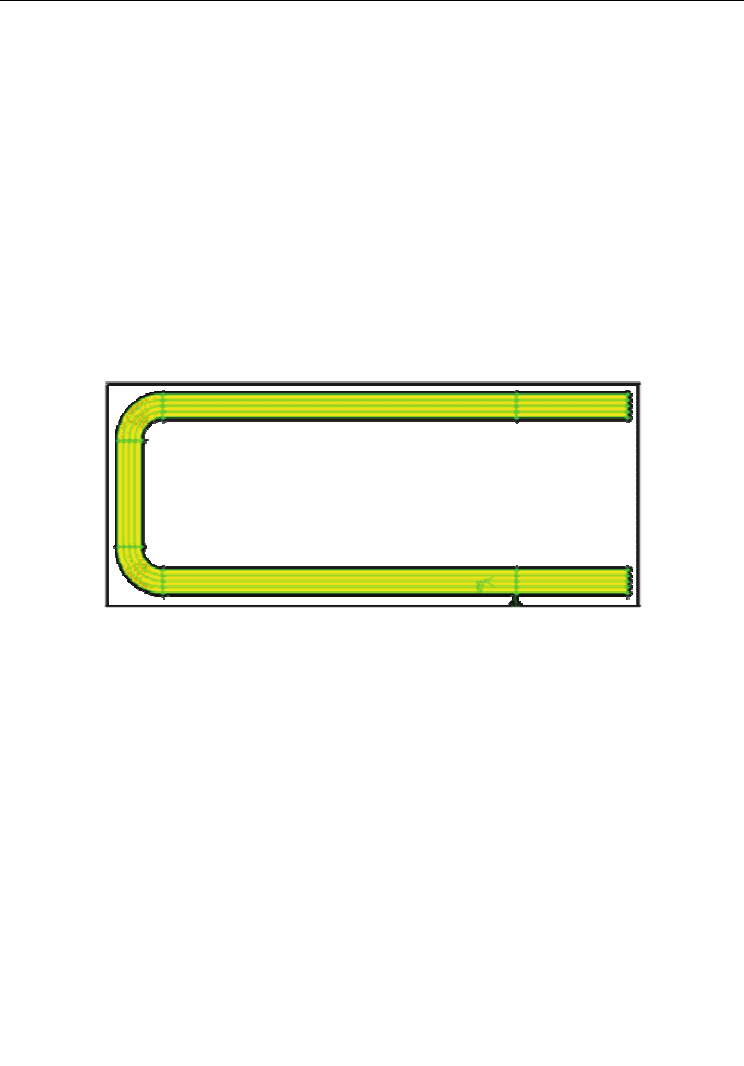
Heat Transfer in Nanostructures Using the Fractal Approximation of Motion
471
where we consider that r
f
/r
p
≈ 0,043 as in (Kumar et al., 2004; Jang&Choi, 2004; Prasher,
2005) and k
eff
= k
nf
;
iii. viscosity. We choose the polynomial approximation based on experimental data
Nguyen (Nguyen et al., 2005), for water – Al
2
O
3
nanofluid:
()
n
ff
2
306 0.19 1
μ
εε
μ
=−+ (98)
These equations were used to perform the calculation of temperature distribution and
transmission fields in the geometry studied.
Figure 7 shows the geometric configuration of the studied model which consists of a
coaxial heat exchanger with length L=64 cm; inner tube diameter d=10 mm and outer tube
diameter D=20 mm. By inner tube will circulate a nanofluid as primary agent, and by the
outer tube will circulate pure water as secondary agent. The nanofluid used is composed
of aluminum oxide Al
2
O
3
particles dispersed in pure water in different concentrations
(1%, 3% and 5%).
Fig. 7. Geometry of coaxial heat exchanger
The continuity, momentum, and energy equations are non-linear partial differential
equations, subjected to the following boundary conditions: at the tubes inlet, “velocity inlet”
boundary condition was used. The magnitude of the inlet velocity varies for the inner tube
between 0,12 m/s and 0,64 m/s, remaining constant at the value of 0,21 m/s for the outer
tube. Temperatures used are 60, 70, 90 degrees C for the primary agent and for the
secondary agent is 30 degrees C. Heat loss to the outside were considered null, imposing the
heat flux = 0 at the outer wall of heat exchanger. The interior wall temperature is considered
equal to the average temperature value of interior fluid. Using this values for velocity, the
flow is turbulent and we choose a corresponding model (k-ε) for solve the equations
(Mayga&Nguyen, 2006; Bianco et al., 2009).
For mixing between the base fluid and the three types of nanofluids were performed
numerical simulations to determinate correlations between flows regime, characterized by
Reynold’s number, and convective coefficient values.
The convective coefficient value h is calculated using Nusselt number for nanofluids
(Al
2
O
3
+H
2
O), relation established following experimental determinations by Vasu and all
(Vasu et al., in press):
n
f
n
f
n
f
Nu
0.8 0.4
0.0023 Re Pr=⋅⋅ (99)
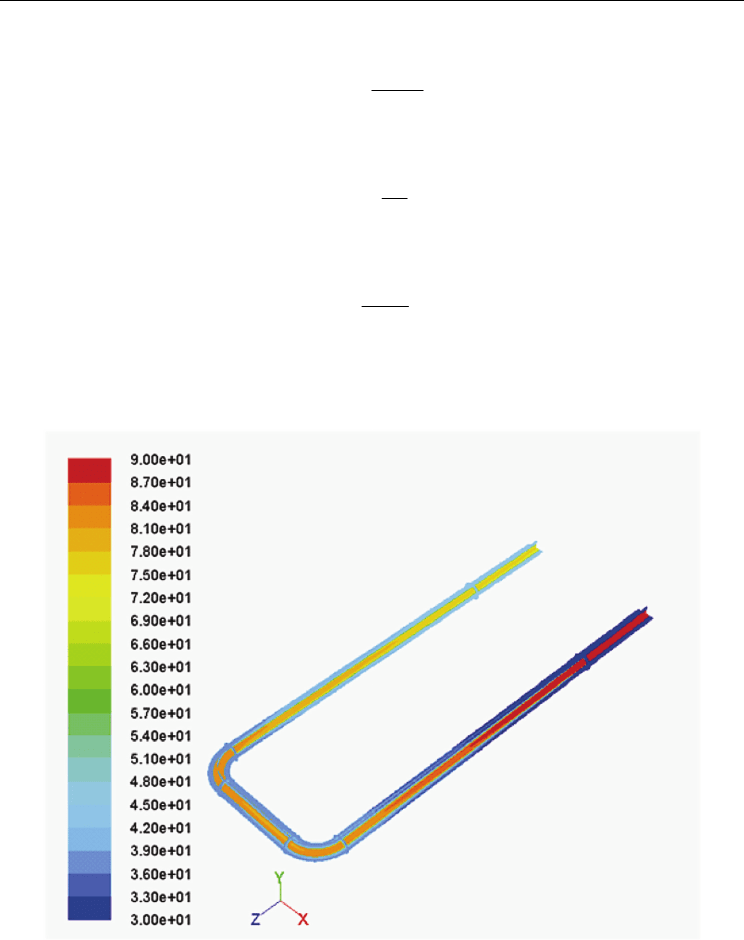
Two Phase Flow, Phase Change and Numerical Modeling
472
where the Reynolds number is defined by:
nf m
nf
nf
vd
Re
ρ
μ
=
(100)
and Prandtl number is :
n
f
nf
n
f
Pr
υ
α
=
(101)
and then, results :
n
f
Nuk
h
d
=
(102)
The temperature and velocity profiles can be viewed post processing. In figure 8 is
illustrated one example of visualization the temperature profile in a case study, depending
by the boundary conditions imposed.
Fig. 8. Temperature profile
Following we analyze the variation of convective heat transfer coefficient in comparison
with flow regime, temperature and nanofluids concentrations.
Figures 9-11 highlights the results of values of water and three types of nanofluids used
depending on the Reynolds number and the primary agent temperature.
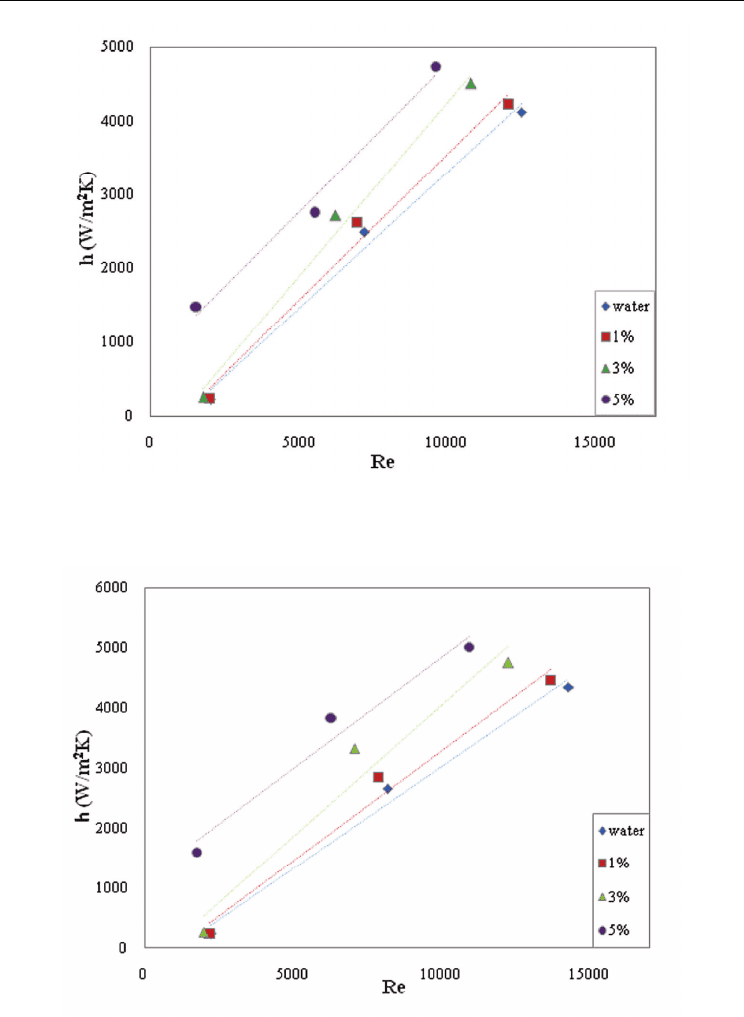
Heat Transfer in Nanostructures Using the Fractal Approximation of Motion
473
Fig. 9. Variation of convective heat transfer coefficient based on the Reynolds number at the
T=60
o
C
Fig. 10. Variation of convective heat transfer coefficient based on the Reynolds number at
the T=70
o
C
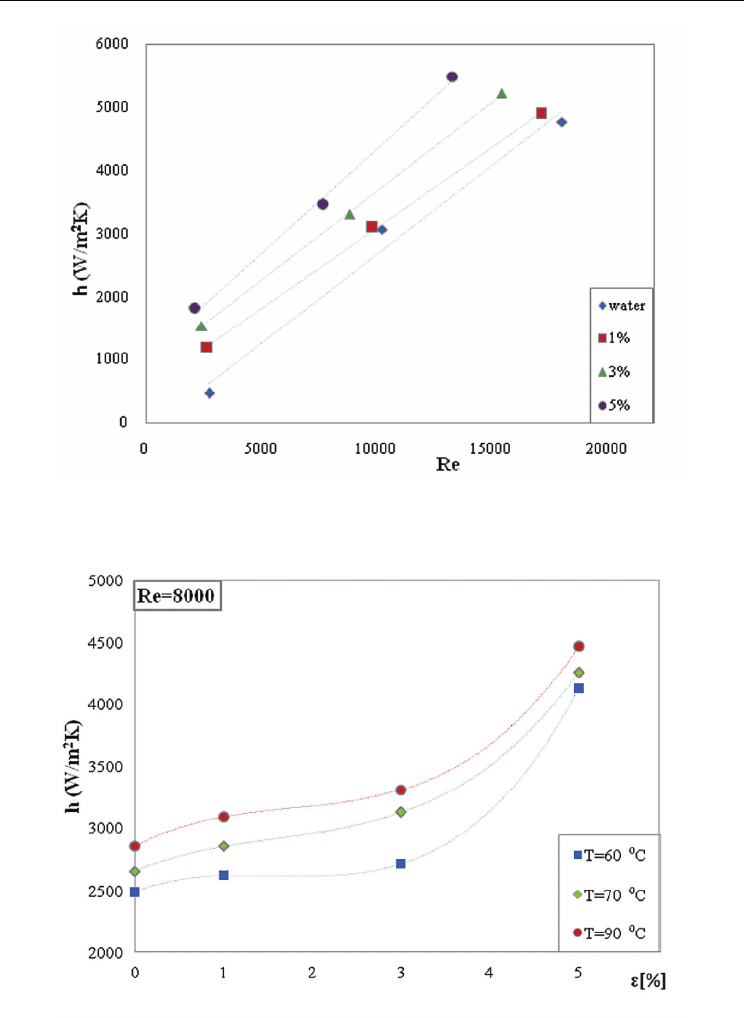
Two Phase Flow, Phase Change and Numerical Modeling
474
Fig. 11. Variation of convective heat transfer coefficient based on the Reynolds number at
the T=90
o
C
Fig. 12. Variation of convective heat transfer coefficient based on temperature at Reynolds
number equal to 8000

Heat Transfer in Nanostructures Using the Fractal Approximation of Motion
475
It can be seen that the value of convective heat transfer coefficient h for water is about 13%
lower than the nanofluids, also parietal heat transfer increases with increasing the primary
agent temperature and implicitly with increasing of volume concentration.
In Figure 12 is represented the variation of convective heat transfer coefficient h depending
on the volume concentration of particles at imposed temperatures (60, 70 and 90 degree C)
for Reynold’s number equal to 8000.
We can notice a significant increase of approximately 50% for convective heat transfer
coefficient for nanofluid at 5% concentration, compared with water at 90 degree C.
5. The dispersive approximation in the heat transfer processes
In the dispersive approximation of the fractal heat transfer the relation becomes a Korteweg
de Vries type equation for the temperature field
()
()
D
F
TT
TdtT
tt
31
32
3
ˆ
2
ˆ
0
3
−
∂∂
=+⋅∇+ ∇=
∂∂
V
D (103)
Separating the real and imaginary parts in Eq.(103), i.e.
()
()
D
F
T
TdtT
t
T
31
32
3
2
0
3
0
−
∂
+⋅∇+ ∇ =
∂
−⋅∇=
V
U
D
(104a,b)
and adding them the heat transfer equation is obtained as:
() ()
()
D
F
T
TdtT
t
31
32
3
2
0
3
−
∂
+−⋅∇+ ∇=
∂
VU D
(105)
From Eq.(104b) we see that at the fractal scale there isn’t any thermal convection.
Assuming that
T
σ
−=VU
, with constant
σ
= (for this assumption see (Agop et al., 2008)),
in the one-dimensional case, the equation (52), with the dimensionless parameters
T
tkx
T
0
,,
τωξ φ
===
(106a-c)
and the normalizing conditions
()
()
D
F
Tk
dt k
3
1
32
3
0
2
1
63
σ
ωω
−
==
D
(107)
takes the form:
60
τξξξξ
φφφ φ
∂+ ∂+∂ =
(108)
Through the substitutions
() ( )
wu,,
θ
φ
τ
ξ
θ
ξ
τ
==−
(109a,b)

Two Phase Flow, Phase Change and Numerical Modeling
476
the Eq.(108), by double integration, becomes
()
u
wFw w wgwh
232
1
22
′
==−−−−
(110)
with g, h two integration constants and u the normalized phase velocity. If
()
Fwhas real
roots, the equation (108) has the stationary solution
()
()
()
Es
au
sa a s
Ks s
2
,, 2 1 2 cn ;
0
2
φξτ ξ τ ξ
=−+⋅ −+
(111)
where
cn is the Jacobi’s elliptic function of s modulus (Bowman, 1953), a is an
amplitude,
0
ξ
is a constant of integration and
()
()
()
()
Ks s d Es s d
22
12 12
22 22
00
1sin , 1sin
ππ
ϕ
ϕϕϕ
−
=− =−
(112a,b)
are the complete elliptic integrals (Bowman, 1953). As a result, the heat transfer is achieved
by one-dimensional cnoidal oscillation modes of the temperature field (see Fig.13a). This
process is characterized through the normalized wave length (see Fig.13b):
()
sK s
a
2
λ
=
(113)
and normalized phase velocity (see Fig.13c):
()
()
Es
ua
Ks s
2
1
43 1
=−−
(114)
In such conjecture, the followings result:
i. the parameter s becomes a measure of the heat transfer. The one-dimensional cnoidal
oscillation modes contain as subsequences for
s 0= the one-dimensional harmonic
waves while for
s 0→ the one-dimensional waves packet. These two subsequences
describe the heat transfer through the non-quasi-autonomous regime. For
s 1= , the
solution (111) becomes a one-dimensional soliton, while for
s 1→ the one-dimensional
solitons packet results. These last two subsequences describe the heat transfer through
the quasi-autonomous regime;
ii. by eliminating the parameter a from relations (113) and (114), one obtains the relation:
()
() () () ()
()
uAs
A
ssEsKssKs
2
222
16 3 1
λ
=
=−−
(115a,b)
We observe from Fig.13d that only for
s 00.7=÷ ,
()
As const.≈ , and u
2
const.
λ
≈ .
According with previous transport regimes, this dispersion relation is valid only for the
non-quasi-autonomous regime. For the quasi-autonomous regime it has no signification.
Moreover, these two regimes (non-quasi-autonomous and quasi-autonomous) are separated
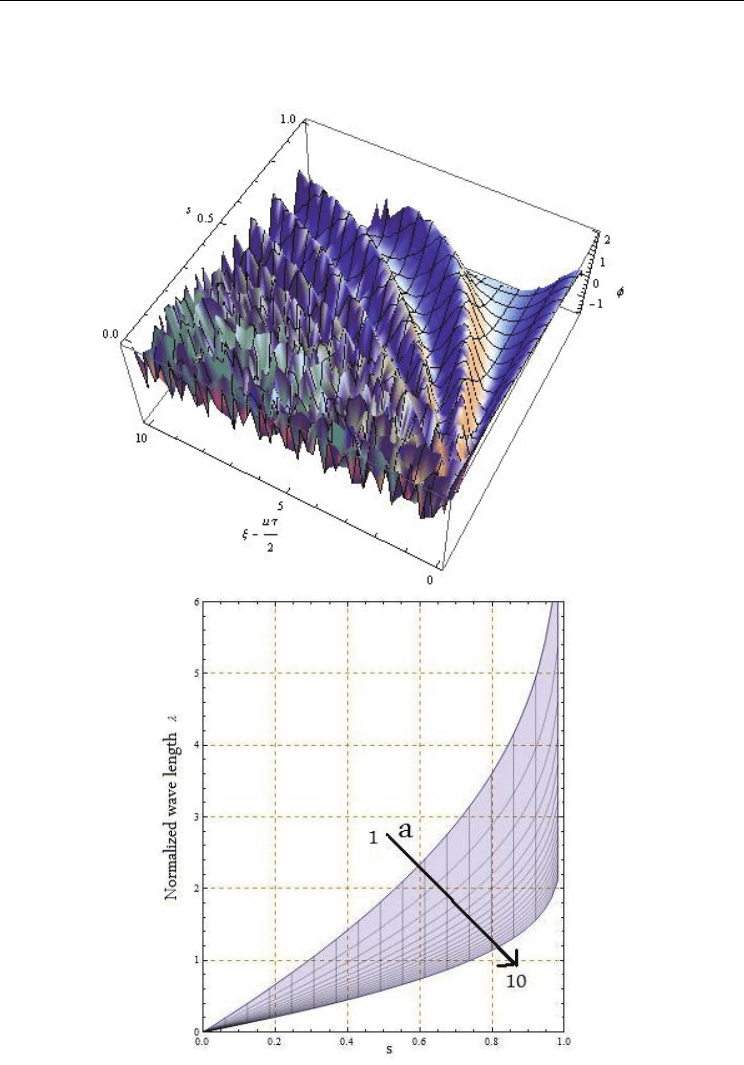
Heat Transfer in Nanostructures Using the Fractal Approximation of Motion
477
by the 0.7 experimental structure (Chiatti et al., 1970). We note that the cnoidal oscillation
modes can be assimilated to a non-linear Toda lattice (Toda, 1989). In such conjecture, the
ballistic thermal phononic transport can be emphasized.
a)
b)
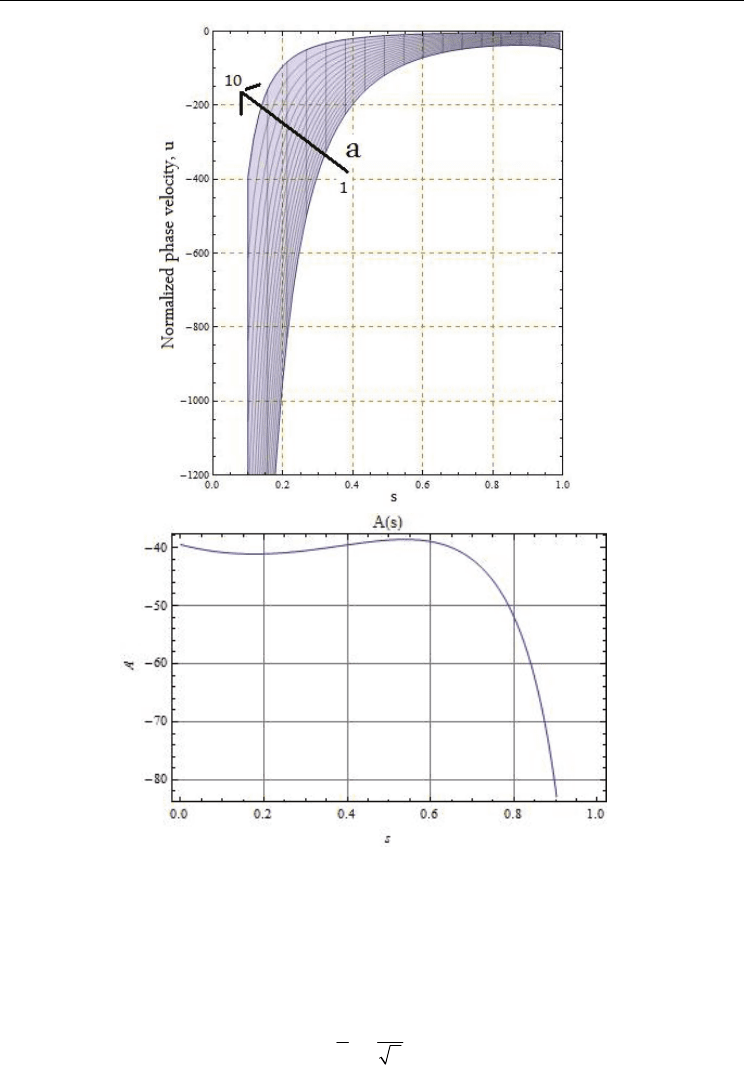
Two Phase Flow, Phase Change and Numerical Modeling
478
c)
d)
Fig. 13. One-dimensional cnoidal oscillation modes of the temperature field (a) ; normalized
wave length (b); normalized phase velocity (c); separation of the thermal flowing regimes
(non-quasi-autonomous and quasi-autonomous) by means of the 0.7 experimental structure
(Jackson, 1991)
Let us study the influence of fractality on the heat transfer. This can be achieved by the
substitutions:
u
wf i
u
2
2
,
4
θ
β
== (116a,b)
